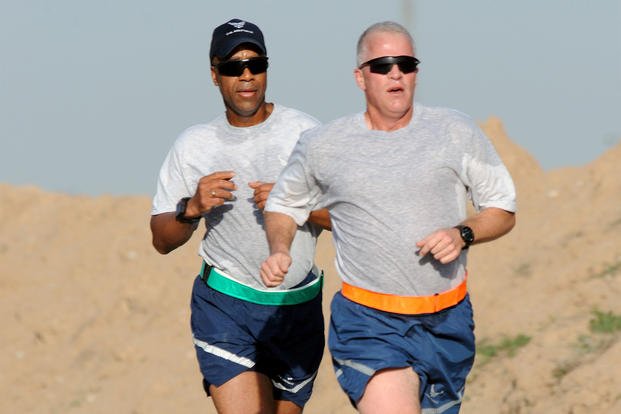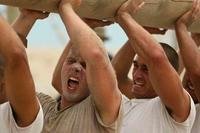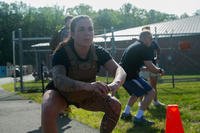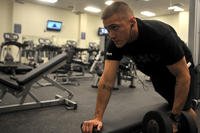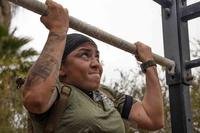Many people do not give themselves enough time to reach certain fitness, weight loss and other performance goals.
Typical cycles to see results that are pushing you toward your goals will be relative to your current fitness, time to train and how hard you are training for a specific goal. Remember the FITT (frequency, intensity, time, type of training) Principle. Here are some things to consider when setting a realistic goal for fitness and health:
1. Goals for timed runs: Dropping your pace for timed runs is usually not overly difficult to reach passing scores, but to maximize the test for promotion points or for competitive special-ops screening programs, it can take time and effort.
If you are trying to get to an eight-minute mile pace to be in the passing zone, that also could be difficult if you are overweight, susceptible to running injuries and have not run in several months or more.
However, a food plan for weight loss, combined with a running plan (alternating non-impact cardio days), can help you progress quickly toward your goal within a six- to 12-week period.
Of course, it is all relative to how much weight you need to lose and how you handle the impact of running. As you progress, you will find that dropping from a seven-minute mile pace to a sub-six-minute mile pace also may take a six- to 12-week period of a steady running program that combines paced tempo and fast interval runs.
2. Strength and muscle endurance goals for PT tests: Fitness tests that have higher-rep calisthenics tests to master typically do not take a great deal of time. For push-ups, pull-ups and sit-ups, for instance, many have increased their numbers significantly by a few weeks of practice prior to the fitness test. Some classic two-week programs can be found on the following links: 15 Days from the PFT, Push-up Push, Pull-up Push, as well as the Sit-up Help programs.
Most success will come from doing the exercises of your PT test every other day, and you will see results within 4-6 weeks. If however, you are seeking maximum scores on the test, this process can take longer and be in the 12- to 18-week zone. Progress with 100+ push-ups and sit-ups and 20+ pull-ups start to slow once you near 80-90 repetitions.
3. Strength goals for lifting: Depending on your fitness foundation (strength or endurance athlete or none), strength gains can come fast or slow. This can be frustrating to new lifters and endurance athletes. However, after a solid six-week course of lifting, gains start to show, and the next six-week cycle can be an exponential increase in strength.
Strength is a unique component of fitness. It is hard to gain at first, easier to maintain but somewhat difficult to lose. You may have experienced missing a week of lifting and coming back stronger than ever before. However, if you miss a week of running, it is like you never have run before. Strength cycles typically vary in four-, six- or eight-week cycles, with a steady progression of increases each week or two.
4. Weight loss or weight gain goals: Whether you are trying to lose or gain weight, it is done in the kitchen primarily. Lifting weights and calisthenics, combined with a variety of cardio options (walk, run, bike, elliptical, doing steady pace or intervals) enhance the fitness component that is part of losing weight or gaining weight. But essentially, if you want to be big, you have to eat big.
It helps to lift big, too, presuming you want to gain muscle mass and not just weight. Weight loss in the end comes down to reducing calories, sugars and burning more calories at the end of the day than you consume. That is a very general approach, but it works.
Reducing carbohydrates (not eliminating) can lead to quick weight loss as well. Simply avoid sugars and breads for a few weeks, and progress with weight loss comes quickly. A good steady pace of weight loss is about 10 pounds a month, and a steady gain of weight/muscle is about 4-5 pounds a month if you are eating well and training hard.
5. Longer-distance running/rucking goals: Long runs and long rucks are a basic progression of steadily increasing distance and weight of about 10% each week until eventually you have reached your goals. If you can stay mobile and stretch well as you increase your mileage, you may be able to decrease the chances of overuse injuries associated with these types of goals.
Once you reach a goal -- no matter what it is -- be sure to get some rest and recovery, especially if it beat you up and was partly a mental gut check. However, you also should have a plan to rebuild and transition to either a similar goal or consider a completely different goal if you need a break from the same old routines. Periodization (moving from one cycle to another every 12 weeks) has been a life saver for me, kept me focused and having fun working out for 20 years. Training will never get old.
The one important thing to remember when training to reach a goal is that fitness and training is a journey, not a destination. I recently met an Ironman finisher who, after the race, gained 30 pounds and lost much of his endurance gains within three months. This would be OK if he had switched goals and rested his joints from the high mileage of preparing for the Ironman and perhaps started lifting to gain some muscle mass. However, doing nothing after a goal is accomplished is not going to help with your overall health goal -- longevity.
If your goals are more PT test-based, you should consider the PFT Bible or the PT Test Survival Guide.
Stew Smith is a former Navy SEAL and fitness author certified as a Strength and Conditioning Specialist (CSCS) with the National Strength and Conditioning Association. Visit his Fitness eBook store if you're looking to start a workout program to create a healthy lifestyle. Send your fitness questions to stew@stewsmith.com.
Want to Learn More About Military Life?
Whether you're thinking of joining the military, looking for fitness and basic training tips, or keeping up with military life and benefits, Military.com has you covered. Subscribe to Military.com to have military news, updates and resources delivered directly to your inbox.
